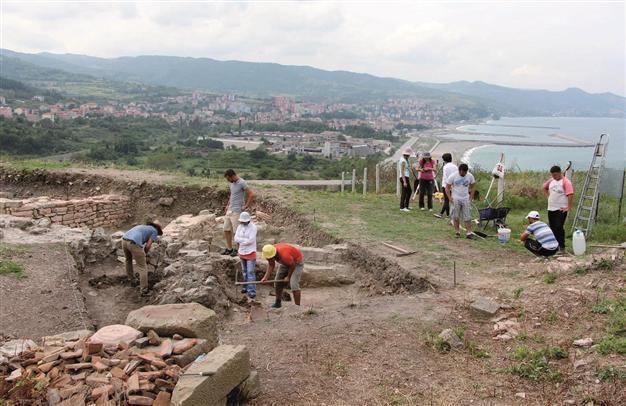'Ephesus of the Black Sea’ unearthed with brushes
ZONGULDAK – Doğan News Agency

Settlement in the ancient city of Tieion continued until the 13th century, according to the archaelogists.
The ancient city of Tieion, which was established in the 7th century in the town of the Filyos district in the Black Sea province of Zonguldak, also known as the “Ephesus of the Black Sea,” has been the place of archaeological excavations for the past eight years. The ancient city covers an area of 60 hectares, with excavations so far completed in in an area covering two hectares, unearthing the ancient remains of a bath, church, temple and grave.The excavations in Filyos that started in 2006 with the support of the Culture and Tourism Ministry and the Zonguldak Provinacial Administration, is headed by Professor Sümer Atasoy of Karabük University’s Archaeology Department, and so far the excavations have unearthed colorful pots and pans, written documents, a bath, temple port, castle, coastal walls, aqueducts, pier remains, an ancient theater, 10 graves, 6 of which are inside the church, metal coins, metal artwork, candles, glass pieces and ceramics.
Experts have estimated that that settlement in the ancient city of Tieion continued until the 13th century. This year, excavations are headed by assistant professor Şahin Yıldırım of Karabük University, along with a team of 45 people, including 20 university students, 10 workers, architects and experts in ceramics and inscriptions.
The traces of a settlement from 700 B.C. known as Kale Tepesi (Castle Hill) has also recently been discovered, which include city walls and buildings from the Archaic and Classical eras.
Yıldırım said excavations would continue until Sept. 15 and they have so far unearthed the first settlement place in the city. “We have found small things in the excavations. There are layers of Byzantine [remains] in the upper parts of the complex; they have been damaged. There are also the remains of medieval walls. This place served as the Genoese castle for many years. There are a lot of medieval-age ceramics around. There also small objects,” he said.
Yıldırım said they were trying to be as quick as possible, adding, “Works progress slowly because of technical works. The excavations are still carried out with digging tools. When necessary, we use brushes and spuds. We have to move according to data. We determine the spots with geophysical measurements. The excavation technique has not reached the scientific level yet. It is not possible to use machines. We have a large archaeological site. This is why I estimate that works will take 100-150 years with the current technology [that we have].”
Yıldırım also noted expropriations were also continuing in the excavation area.
















